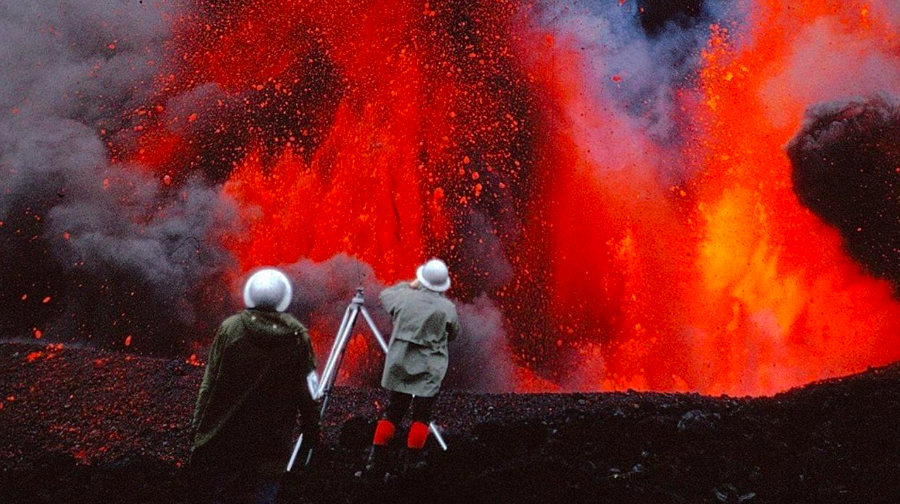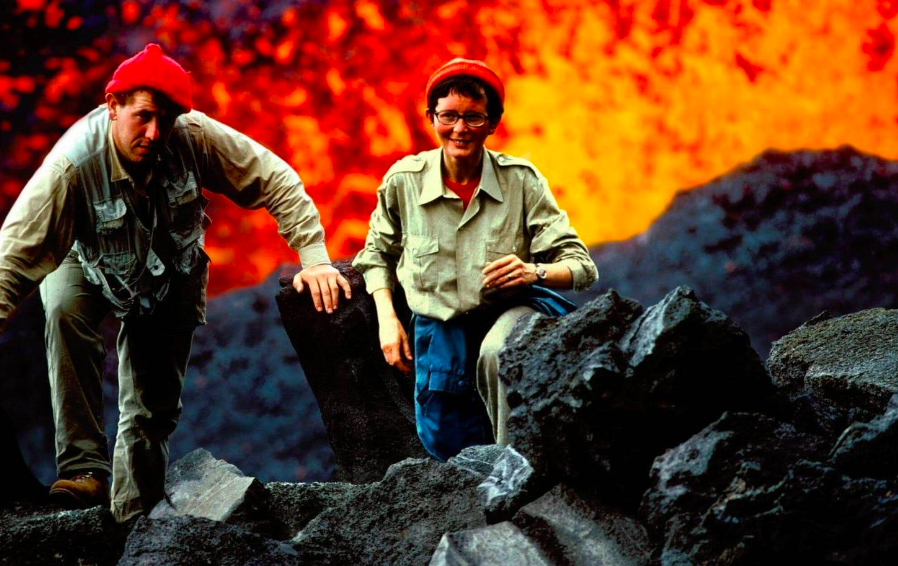If the stillness is Volcanic: Sara Dosa’s Fire of Love (2022) and Werner Herzog’s The Fire Within (2022)

I have never seen “Volcanoes”— But, when Travelers tell How those old—phlegmatic mountains Usually so still— Bear within—appalling Ordnance, Fire, and smoke, and gun, Taking Villages for breakfast, And appalling Men— If the stillness is Volcanic In the human face When upon a pain Titanic Features keep their place— If at length the smoldering anguish Will not overcome— And the palpitating Vineyard In the dust, be thrown? If some loving Antiquary, On Resumption Morn, Will not cry with joy "Pompeii"! To the Hills return! —Emily Dickinson
Raul Ruiz wrote: “They are angels that carry out infernal tasks under the direct command of God” and I want to imagine that he imagined volcanoes. Centuries after the crime, the gun is still smoking. The angel’s open mouth will be able to empty his entrails only when God issues the order. At the corners of this mouth, two ants, devoted to a delicious dream climb.
The French scientists Katia and Maurice Krafft, moved by love and devotion, dedicated their lives to the study of volcanoes, establishing a neighborly relationship with phlegmatic mountains that sweated sparkling rivers of lava. In those deformed and monstrous figures, the volcanologists intensely but stealthily observe the silent mirror that embodies The Volcano. “Because there is nothing that love does not engulf” Hadewijch from Antwerp would write about the figure of God and devotion to him.
The devotion and mystical curiosity of Katia and Maurice for the insular volcanoes had sealed them in their coexistence, understanding that theirs was an impossible movement, but this never stopped the inflammation of their desire to see God face to face, hidden in stillness, in the volcanic solitude.
Even with full knowledge of the artillery inside, little by little we see the French couple climbing stones as if avoiding the guardians of a castle. In some early images, nothing seems to happen, a consequence of recording their careful study, observation and meditation on volcanoes. They know in The Volcano a reverse of the desert, of the pure surface. Behind the mask reigns disorder, the apeiron. Although everything emanates life there, an erotic of darkness resides in the illuminated figures and substances, a dark prediction and entanglement with the thanatic.
Sara Dosa, builds her documentary Fire of Love (2022) from the material that Katia and Maurice filmed from their hand-to-hand work with volcanoes. It is the material that Wener Herzog uses to construct The Fire Within (2022). The names of each documentary give an unintended account of the spirit that mobilizes them.
While Dosa inaugurates the exciting power of a dream, a renewed embrace of the world; Herzog interprets this escape as a good door to a nightmare. Ursula Le Guin would write: “Each utopia contains a dystopia, each dystopia contains a utopia.” Fire of Love weaves together a tapestry of love and passion, the glow of visual delight and musical joy, compressed to maximize the shock and miracle that the Kraffts embodied. The Fire Within, however, moves in opaque and viscous fields, where listening and looking exist in a state of sober contemplation and premature mourning.
Forty-six years ago, Herzog and two of his cameramen arrived at Base-Terre, the southern tip of the island of Guadeloupe in France. In a ghostly and spectral landscape, they come across a giant inflamed rock and a multitude of wandering animals: donkeys, cats and dogs roam the streets and houses incomprehensibly and arbitrarily. We do not see men, women or children. However, the animal entourage has been joined by a human.
There they go in search of a peasant who, according to testimonies, in a kind of animal state, has surrendered their fear before the imminent disaster of a volcano, which is about to erupt and engulf everything in its path. They find him taking a nap in the park, watching people leave their houses in frantic fear. In him there is something, a core that denies him the will to move. But the man is opaque to us. In this moment of despair, which is a divine moment, man does not deny having imagined himself falling into the stomach of death. Instead he sings in a state of grace and flees inwards, towards an interior armor.
Herzog speaks to us while flying over the island of Guadalupe: “I have the impression that these are the last images taken of this town.” With precocious regret, Herzog predicts and recognizes in the volcano a violence without cruelty or viciousness. Meanwhile, the farmer lets himself be consumed by paralysis, as if he has decided to get ahead of the mystery. The mute peasant is entering the imaginary territory of death in a state of lightness. The moment of imminence has left him still, waiting.
Dosa and Herzog invest their gaze on two decidedly different surfaces of the taut rope on which Katia and Maurice walk: the glow and the burn.

Dosa and Herzog invest their gaze on two decidedly different surfaces of the taut rope on which Katia and Maurice walk: the glow and the burn.
For Dosa, the aesthetic and erotic decision is to go to the limit of the great dream, with death as a trap to be traversed. Herzog remains in the horror of the scream, the violent beauty of each volcanic episode. Dosa has managed to fascinate with the living; Herzog has been left to watch their collapse, in lethargy before the wound of the volcano.
Both find the presence of Eros. It inflames the volcanologists, who are together in love with their mutual movement towards the volcano peak. It is the same power that held their gaze, meditative and calm, waiting for the volcano to make its move. The same power inflamed the peasant’s throat with music while he lay waiting for his rebellious death. Each filmmaker recognizes in this the thanatic authority with which the interior of the earth spits out and covers entire territories, ruthlessly surprises and leaves only the deformed mass of everything that exists.
Stillness and movement, both, are the symptoms and evidence of life. The contradiction between them is not a failure of meaning. On the contrary, it opens the meaning itself. Life irrepressibly turns into a movement that seeks death, as any chaos advances towards its own eradication. All erotic force is a symptom of the thanatotic core that waits, inescapable.
About Natalia Peralta
Natalia Peralta is a filmmaker and critic living in Bogotá, Colombia.





